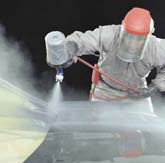One of the least understood issues when managing the risk of hearing loss is the combined exposure to noise and ototoxic chemicals.
There is widespread potential for hearing loss in Vehicle Repair Workshops. Prolonged and excessive exposure to noise results in long term harm to your hearing. This is irreversible, once you lose your hearing that’s it – it’s gone!
Exposure to some chemicals can result in hearing loss. These chemicals are known as ototoxic substances. Hearing loss is more likely to occur if a worker is exposed to both noise and ototoxic substances.
Many high noise activities are regularly undertaken at Vehicle Repair workshops. Removing and repairing body panels using pneumatic tools can be noisy work: air saws and chisels can typically produce levels as high as 107 dB(A) and grinders and orbital sanders 97 dB(A). Noise levels from panel beating and other repair operations using hand tools are variable but generally high. Welding and flame-cutting can also be noisy, and paint booths have been measured at 90 dB(A).
Many commonly used chemicals in Vehicle Repair workshops are ototoxic substances. For organic solvents such as toluene, styrene or xylene, the combined exposure with noise increases the risk of hearing loss in a synergistic manner.
Exposure standards for chemicals and noise have not yet been altered to take account of increased risk to hearing. The Managing Noise and Preventing Hearing Loss at Work Code of Practice 2011, recommends that the daily noise exposure of workers exposed to ototoxic substances be controlled to 80 dB(A) or below and that workers exposed to ototoxic substances undergo audiometric testing.
Control measures such as substitution, isolation and local ventilation should be implemented to eliminate or reduce exposures. Personal protective equipment should be used to prevent skin and respiratory absorption when other controls are insufficient.
In many situations exposure to ototoxic substances can be eliminated or reduced through substitution with safer alternatives. There are readily available safer alternatives to the solvents used for parts degreasing, brake cleaning, cleaning paint equipment and surface preparation. Some examples of safer alternatives can be found at the Environmental Fluids Systems website.
For information on workplace noise assessments click here.
For information on hazardous chemical risk assessments click here.











